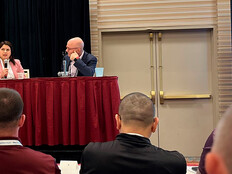With so many federal departments interested in adding robotic automation processes to ease their workloads, there’s a danger that the new “digital intern” may be employed only by the agencies that created them, says a Defense Department RPA program manager.
“One of the things that makes me sad is that you have a lot of groups in DOD moving to RPA, and that’s great,” says Erica Thomas, the RPA program manager for the Office of the Under Secretary of Defense (Comptroller). “But you have all of them in silos. No one was sharing what they were doing, no one was sharing their code.
“So what we have said is that anything we build, we will share it. What we don’t want to have happen is automation being built repetitively across departments,” Thomas said at Imagine Nation ELC 2019 in Philadelphia on Monday.
RPA is in use in at least 50 agencies so far, with an informal count of 128 bots in DOD alone, according to a survey done by the department in August. NASA was the first agency to install RPA and bots, in 2017; its Washington bot has its own email address and credentials.
JOIN THE CONVERSATION: Follow @FedTechMagazine on Twitter for continued Imagine Nation ELC 2019 coverage.
Mundane Work Is Necessary — But not for Humans
The bots often handle routine, repetitive work that takes up humans’ valuable time — cutting and pasting information into spreadsheets, filling out forms, or sorting information from incoming documents.
“Think of that bot as a digital intern. Summer rolls around, someone says, ‘I’m not going to do this boring, mundane work anymore — I’m going to give it to the intern.’ That’s the same thing you can do with a bot,” said James Walker, federal CTO at UiPath, which helped build the NASA bot.
For instance, the Department of Housing and Urban Development has a bot that sorts through documentation of failed mortgages for information needed to see what went wrong. The form for each such case has 35 fields, and HUD needs data from only 17 of those.
“Six FTE’s worth of people had to stop and pull that information off and register it on their dashboard,” he said. “Call it low-value work, but I would call it necessary work. At the end of the day, HUD has to have that data. It’s just not necessary for you or I to do that work.”
The General Services Administration demonstrated one of its bots at Imagine Nation ELC 2019.
Bots Work Well in Financial Services
At the General Services Administration, bots handle payroll reports, changes on lease agreements and other financial tasks, said Mark Grgurich, an RPA developer in GSA’s office of the CFO.
The agency also used its RoboMod pilot to correct 460,000 products listed on GSA Advantage! as made in America to their actual country of origin. “If you can imagine GSA employees having to read through and check country of origin —the best we could ever do was a spot check. This gives us a much better way to approach the process,” said GSA Administrator Emily Murphy.
The IRS is studying possible RPA applications for many financial services as well. “The RPA software that’s available makes it easy to develop that automation,” said Reza Rashidi, the agency’s executive lead for robotics process and intelligent automation.
DOD has found automation most valuable in financial areas, especially in the wake of its first-ever audit last year, which it failed. RPA could help the sprawling department and its four service branches better coordinate financial information, Thomas said.
RPA has many benefits, she said, including improvements in accuracy, quality and compliance. “Frankly, it’s an employee morale booster. The things we’re building and automating are not things our employees enjoy doing.”
Follow FedTech coverage for more articles and videos from Imagine Nation ELC 2019.










